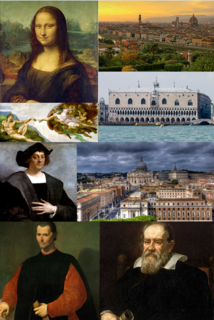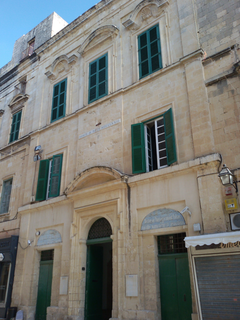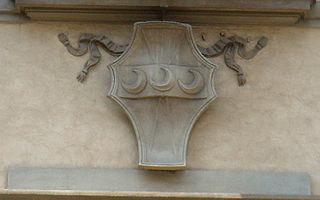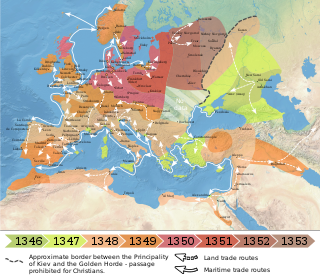
Giovanni Boccaccio was an Italian writer, poet, correspondent of Petrarch, and an important Renaissance humanist. Boccaccio wrote a number of notable works, including The Decameron and On Famous Women. He wrote his imaginative literature mostly in the Italian vernacular, as well as other works in Latin, and is particularly noted for his realistic dialogue which differed from that of his contemporaries, medieval writers who usually followed formulaic models for character and plot.

The House of Medici was an Italian banking family and political dynasty that first began to gather prominence under Cosimo de' Medici in the Republic of Florence during the first half of the 15th century. The family originated in the Mugello region of Tuscany, and prospered gradually until it was able to fund the Medici Bank. This bank was the largest in Europe during the 15th century, and it facilitated the Medicis' rise to political power in Florence, although they officially remained citizens rather than monarchs until the 16th century.

Cosimo di Giovanni de' Medici, called "the Elder" and posthumously "Father of the Fatherland", was an Italian banker and politician, the first member of the Medici political dynasty that served as de facto rulers of Florence during much of the Italian Renaissance. Despite his influence, his power was not absolute; Florence's legislative councils at times resisted his proposals throughout his life, and he was always viewed as primus inter pares rather than an autocrat. His power derived from his wealth as a banker, and he was a great patron of learning, the arts and architecture.

Cosimo I de' Medici was the second Duke of Florence from 1537 until 1569, when he became the first Grand Duke of Tuscany, a title he held until his death.

The Italian Renaissance was a period of Italian history that began in the 14th century (Trecento) and lasted until the 17th century (Seicento). It peaked during the 15th (Quattrocento) and 16th (Cinquecento) centuries, spreading across Europe and marking the transition from the Middle Ages to Modernity. The French word renaissance means "Rebirth" and defines the period as one of cultural revival and renewed interest in classical antiquity after the centuries labeled the Dark Ages by Renaissance humanists. The Renaissance author Giorgio Vasari used the term "Rebirth" in his Lives of the Most Excellent Painters, Sculptors, and Architects but the concept became widespread only in the 19th century, after the works of scholars such as Jules Michelet and Jacob Burckhardt.

A cassone or marriage chest is a rich and showy Italian type of chest, which may be inlaid or carved, prepared with gesso ground then painted and gilded. Pastiglia was decoration in low relief carved or moulded in gesso, and was very widely used. The cassone was one of the trophy furnishings of rich merchants and aristocrats in Italian culture, from the Late Middle Ages onward. The cassone was the most important piece of furniture of that time. It was given to a bride and placed in the bridal suite. It would be given to the bride during the wedding, and it was the bride's parents' contribution to the wedding.

Michelozzo di Bartolomeo Michelozzi (1396–1472) was an Italian architect and sculptor. Considered one of the great pioneers of architecture during the Renaissance, Michelozzo was a favored Medici architect who was extensively employed by Cosimo de' Medici. He was a pupil of Lorenzo Ghiberti in his early years and later collaborated with Donatello.

A mount of piety is an institutional pawnbroker run as a charity in Europe from Renaissance times until today, more often referred to by the relevant local term, such as monte di pietà (Italian), mont de piété (French) or monte de piedad (Spanish). Similar institutions were established in the colonies of Catholic countries; the Mexican Nacional Monte de Piedad is still in operation.

Strozzi is the name of an ancient Florentine family, who like their great rivals the Medici family, began in banking before moving into politics. Until its exile from Florence in 1434, the Strozzi family was by far the richest in the city, and was rivaled only by the Medici family, who ultimately took control of the government and ruined the Strozzi both financially and politically. This political and financial competition was the origin of the Strozzi-Medici rivalry. Later, while the Medici ruled Florence, the Strozzi family ruled Siena, which Florence attacked, causing great animosity between the two families. Soon afterwards, the Strozzi married into the Medici family, essentially giving the Medici superiority.

Florence is a major historical city in Italy, distinguished as one of the most outstanding economic, social, cultural, political and artistic centres in the Italian peninsula from the Late Middle Ages to the Renaissance. Florence in the 1400s adopted art, sculpting and science into its culture. This era was called the renaissance. It was founded by the medici family who started to use interest on their banking.
Settimia Caccini was a well-known Italian singer and composer during the 1600s being one of the first women to have a successful career in music. Caccini was highly regarded for her artistic and technical work with music. She came from a family of well-known composers and singers, with her father being Giulio Caccini and her sister Francesca Caccini. Caccini was less well-known because she never published any of her own music composed pieces of music. Instead she was known much more for her talent as a singer, who sang for nobility across Italy. It is thought that she did compose her own music but instead of publishing and releasing it to be performed instead she kept it for herself to perform in private. One of her pieces was eventually published posthumously. Coming from a musical family, she was able to lead herself to her own fame and success.
Alessandra Macinghi Strozzi was a Florentine Renaissance business and noblewoman known for her preserved correspondence which chronicled her financial and political struggles in Medici Florence. Strozzi was largely family oriented and worked hard to place her sons in successful banking positions and all her children beneficial marriages. Seventy-three of her letters were preserved by her son Filippo and are now housed by the Archivio de Stato di Firenze. Strozzi's letters rank among the most significant primary sources from fifteenth-century Florence.

The Medici Bank was a financial institution created by the Medici family in Italy during the 15th century (1397–1494). It was the largest and most respected bank in Europe during its prime. There are some estimates that the Medici family was, for a period of time, the wealthiest family in Europe. Estimating their wealth in today's money is difficult and imprecise, considering that they owned art, land, and gold. With this monetary wealth, the family acquired political power initially in Florence, and later in the wider spheres of Italy and Europe.

Giovanna Garzoni (1600–1670) was an Italian painter who was prominent in Europe during the Baroque period. Garzoni started her career painting religious, mythological, and allegorical subjects but became famous for her works with tempera and watercolors of botanical subjects. The artist rose to prominence due to her precision and balance with space and scientific realism of her subjects. Garzoni was often called the Chaste Giovanna due to her vow to remain a virgin. Garzoni is also notable for being one the few women who opted to travel throughout Europe and receive an education during the 17th century instead of settling down and starting a family. Scholars have speculated Garzoni may have been influenced by fellow botanical painter Jacopo Ligozzi although details about Garzoni's training are widely unknown.
The Fair Maid of the Inn is an early 17th-century stage play, a comedy in the canon of John Fletcher and his collaborators. It was originally published in the first Beaumont and Fletcher folio of 1647. Uncertainties of the play's date, authorship, and sources make it one of the most widely disputed works in English Renaissance drama.
Banking in Italy has, as of 11 October 2008, an average leverage ratio (liabilities/assets) of 12 to 1, while the banks's short-term liabilities are equal to 86% of the Italian GDP or 43% of the Italian national debt.
Lucia Visconti was the daughter of Bernabò Visconti, Lord of Milan, and Beatrice Regina della Scala. She was one of seventeen legitimate children.

The dowry system in India refers to the durable goods, cash, and real or movable property that the bride's family gives to the bridegroom, his parents, or his relatives as a condition of the marriage. Dowry stemmed from India's skewed inheritance laws, and the Hindu Succession Act needed to be amended to stop the routine disinheritance of daughters. Dowry is essentially in the nature of a payment in cash or some kind of gifts given to the bridegroom's family along with the bride and includes cash, jewellery, electrical appliances, furniture, bedding, crockery, utensils and other household items that help the newlyweds set up their home. Dowry is referred to as Dahez in Arabic. In far eastern parts of India, dowry is called Aaunnpot.

Bride price, bridewealth, or bride token, is money, property, or other form of wealth paid by a groom or his family to the family of the woman he will be married to or is just about to marry. Bride price can be compared to dowry, which is paid to the groom, or used by the bride to help establish the new household, and dower, which is property settled on the bride herself by the groom at the time of marriage. Some cultures may practice both dowry and bride price simultaneously. Many cultures practiced bride pricing prior to existing records.



















